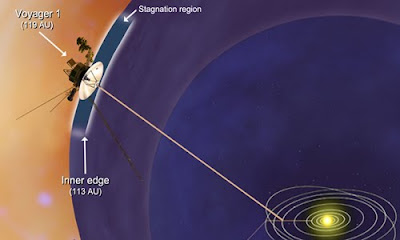NASA's Voyager 1 spacecraft has entered a new region between our solar system and interstellar space. Data obtained from Voyager over the last year reveal this new region to be a kind of cosmic purgatory. In it, the wind of charged particles streaming out from our sun has calmed, our solar system's magnetic field has piled up, and higher-energy particles from inside our solar system appear to be leaking out into interstellar space.
"Voyager tells us now that we're in a stagnation region in the outermost layer of the bubble around our solar system," said Ed Stone, Voyager project scientist at the California Institute of Technology in Pasadena. "Voyager is showing that what is outside is pushing back. We shouldn't have long to wait to find out what the space between stars is really like."
Although Voyager 1 is about 11 billion miles (18 billion kilometers) from the sun, it is not yet in interstellar space. In the latest data, the direction of the magnetic field lines has not changed, indicating Voyager is still within the heliosphere, the bubble of charged particles the sun blows around itself. The data do not reveal exactly when Voyager 1 will make it past the edge of the solar atmosphere into interstellar space, but suggest it will be in a few months to a few years.

No comments:
Post a Comment